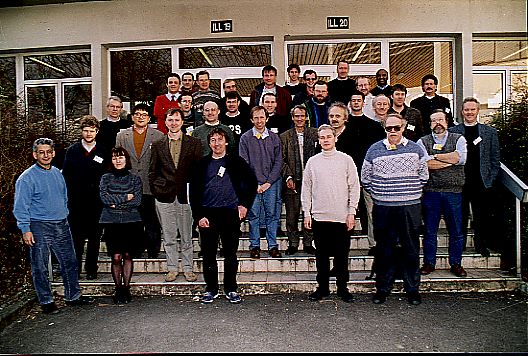canSAS-I: Difference between revisions
No edit summary |
|||
| Line 7: | Line 7: | ||
=== Interchange programs for treated SAXS and SANS data === | === Interchange programs for treated SAXS and SANS data === | ||
---- | ---- | ||
Revision as of 09:20, 22 May 2013
canSAS
Collective Aid for Nomadic Small-Angle Scatterers
Grenoble 4th - 6th February 1998
Interchange programs for treated SAXS and SANS data
The canSAS workshop

click on picture for better resolution
Representatives from major large scale facilities with SAXS or SANS instruments met at Grenoble, 4-6 February, for the jointly organised (ILL/ESRF/DUBBLE) workshop on Collective Aid for Nomadic Small Angle Scatterers. This was a first attempt to try to alleviate the problems that beset visiting users of these facilities due to differences in the data formats between each facility and existing data analysis software. At present each site has its own format and usually their own analysis programs as well. This is clearly an unsatisfactory situation. Visitor lists of large scale facility users showed that the problem concerns between 800-1000 neutron user groups. Keeping in mind that several new synchrotron radiation facilities will be becoming operational in the near future it can be assumed that this number will rise considerably.
Software responsibles with experience in SAS from the major facilities in Europe (EMBL-Hamburg/HASYlab, ESRF, SRS-Daresbury, ILL, ISIS, HMI, PSI, GKSS, FZ-Jülich), the US, ( APS, BNL, IPNS, LANSCE, NIST, NSLS, ORNL) and Japan (Spring8) were invited. In addition the meeting was opened to representatives from the groups with Glatter, Svergun, Stribeck and CCP13 (well known developers of analysis software) and representatives from the NeXus and CIF data-format development groups. A representative of the IUCr-SAS committee was also invited to the meeting.
Plenary demonstrations and talks were interleaved with 'hands-on' sessions for small working groups to discuss and demonstrate their own work, but, more importantly, to assess the principal problem areas. Each of these groups was assigned a 'rapporteur'. The activities of the five groups thus proceeded in parallel, and allowed the full subject field to be well covered, with progress summaries presented by the rapporteurs in the plenary meetings.
The successive stages from performing experiments to a fully analysed data sets are generally as follows:
- production of data
- very instrument dependent how the data comes out
- somewhere a data format is defined
- reduction (background subtraction, normalisation etc.)
- software requires specific input format and either outputs data with same format or defines new format
- analysis
- software again requires a certain input format and produces data with the same format or defines new format
- comparison with modelled data
- software again requires a specific input format
At each central facility the link between 1 and 2 will be taken care of. The links 2-3 and 3-4 are not necessarily provided. This is where the main problems arise, resulting in inefficient use of the data, frustrations for instrument responsibles and further frustrations for users.
Klosowski (NIST) showed the advantages that the NeXus file format could offer while Hammersley (ESRF) highlighted an alternative format (imageCIF), under development, which caters very well for large 2D image-plate datasets. Ghosh (ILL) and Hjelm (Los Alamos) each stressed the importance of storing experimental parameters in a data file beside the data itself. To help infrequent users it was important that the parameters were clearly named and the units were shown. The number of parameters that should be stored in Time of Flight data sets was shown to be considerably greater than with more conventional SANS (or SAXS) instruments. Capel (Brookhaven SR) showed an impressive software suite for data analysis and primary data reduction.
The results of the working party discussions quickly converged on a simple list of priorities.
There was a general consensus for continuing contacts and common action on a number of points. For each of these points a volunteer was found willing to co-ordinate and stimulate activities during the coming year.
- A web repository should be established containing an inventory of existing data formats.
- At present there is need for a translation tool to which people can adapt their own routines.
In the longer term the target should include:
- A dictionary of terms that should go in a data format file should be created.
- The definition of a standard data format for static one dimension reduced data as an initial step. Aspects of simple compatibility with spread-sheet analysis was important.
- It would be useful to make a compilation of available data analysis software and literature.
- For time-resolved, large two dimensional data-sets etc., the NeXus file format was considered an acceptable and flexible solution.
The NeXus development group should be persuaded to try to develop a working set of names better adapted to the SAS community.
The need for a follow-up meeting was expressed by many of the participants. Therefore this will be organised as a workshop associated with the XI SAS conference in Brookhaven May 1999.
Organisers: Claudio Ferrero (ESRF), Ron Ghosh, Peter Timmins, Roland May (all ILL), Wim Bras (DUBBLE CRG/ESRF)
| class="rightColumn" width="200" align="left" |
|- | class="footer" colspan="3" width="960" align="left" |
|}